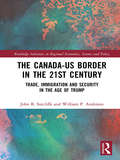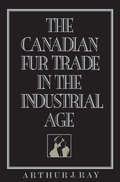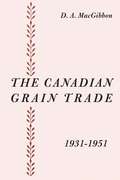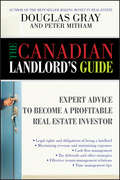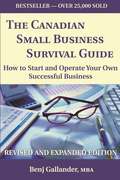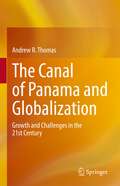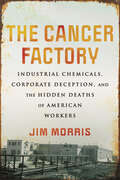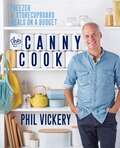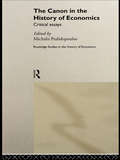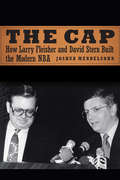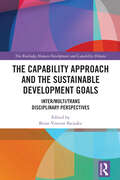- Table View
- List View
The Canada Model and Post-Brexit EU Trade Relations: Insights from the 'Other' Transatlantic Partner (Dealing with Europe)
by Amy Verdun Nanette NeuwahlThis book provides an overview of the relationship between Canada and the European Union (EU), offering a comprehensive treatment of the ‘Canada model,’ frequently mentioned in the discussions surrounding Brexit.Addressing the issues in three ways: examining the economic relations between Canada and the EU, comparing the essence of Canada’s relationship to the EU with that of the United Kingdom (UK) post-Brexit, and considering the relations with their respective large neighbours, this book offers a deeper understanding of what the ‘Canada model’ really means. Contributions from different disciplinary perspectives provide expert, accessible coverage by analysing both the relationships between Canada and the EU, and between the UK and its partners.This book will be of key interest to scholars, students, and practitioners of EU politics, British politics, Canadian politics, international trade, comparative politics, and international relations.
The Canada Pension Plan Investment Board (CPP Investments): April 2021
by Josh Lerner Reza Satchu Alys FerragamoThe Canada Pension Plan Investment Board (CPPIB) is one of the largest pools of investment capital in the world and follows a rigorous "Total Portfolio Framework" in its approach to investment management. In April of 2021, John Graham was just two months into his role as Chief Executive Officer, and he must decide how to lead the organization to outperform the increasingly competitive market. CPPIB had several structural and developed competitive advantages, but with assets under management projected to grow to C$1 trillion by 2030, Graham faced the challenge of scaling the organization's investment strategy for the future. As Graham settled into the chief executive's role, would he be able to lead CPPIB to meet its strategic goals?
The Canada Pension Plan Investment Board: October 2012
by Josh Lerner Matthew Rhodes-Kropf Nathaniel BurbankThe Canada Pension Plan Investment Board (CPPIB) is one of the largest and fastest-growing pools of investment capital in the world and follows an unusually active program of investment management. In October of 2012, Mark Wiseman was just 12 weeks into his role as chief executive officer, and he must decide how to lead the organization to outperform the market as it grows larger and more geographically disperse. After seven years of eschewing the use of intermediaries and successfully practicing its "do-it-yourself mega-investing" approach, CPPIB had garnered admiration from institutions on Bay Street and Wall Street alike. It had even been heralded as a "Maple Revolutionary" by The Economist. With assets under management projected to grow to C$275 billion by 2020, however, Wiseman faced the challenge of how to scale the organization's investment strategy for the future. As Wiseman settled into the chief executive's role, would he be able to lead CPPIB to meet its goals?
The Canada-US Border in the 21st Century: Trade, Immigration and Security in the Age of Trump (Routledge Advances in Regional Economics, Science and Policy)
by William P. Anderson John B. SutcliffeBorders are critical to the development and survival of modern states, offer security against external threats, and mark public policy and identity difference. At the same time, borders, and borderlands, are places where people, ideas, and economic goods meet and intermingle. The United States-Canada border demonstrates all of the characteristics of modern borders, and epitomises the debates that surround them. This book examines the development of the US-Canada border, provides a detailed analysis of its current operation, and concludes with an evaluation of the border’s future. The central objective is to examine how the border functions in practice, presenting a series of case studies on its operation. This book will be of interest to scholars of North American integration and border studies, and to policy practitioners, who will be particularly interested in the case studies and what they say about the impact of border reform.
The Canadian Fur Trade in the Industrial Age
by Arthur RayThroughout much of the nineteenth century the Hudson's Bay Company had a virtual monopoly on the core area of the fur trade in Canada. Its products were the object of intense competition among merchants on two continents - in Leipzig, New York, London, Winnipeg, St Louis, and Montreal. But in 1870 things began to change, and by the end of the Second World War the company's share had dropped to about a quarter of the trade. Arthur Ray explores the decades of transition, the economic and technological changes that shaped them, and their impact on the Canadian north and its people.Among the developments that affected the fur trade during this period were innovations in transportation and communication; increased government involvement in business, conservation, and native economic welfare; and the effects of two severe depressions (1873-95 and 1929-38) and two world wars.The Hudson's Bay Company, confronting the first of these changes as early as 1871, embarked on a diversification program that was intended to capitalize on new economic opportunities in land development, retailing, and resource ventures. Meanwhile it continued to participate in its traditional sphere of operations. But the company's directors had difficulty keeping pace with the rapid changes that were taking place in the fur trade, and the company began to lose ground.Ray's study is the first to make extensive use of the Hudson's Bay Company archives dealing with the period between 1870 and 1945. These and other documents reveal a great deal about the decline of the company, and thus about a key element in the history of the modern Canadian fur trade.
The Canadian Grain Trade, 1931-1951
by Duncan MacGibbon<p>This book traces in an accurate and objective manner the sequence of events during the last twenty years which have influenced the organization fo the Canadian grain trade. During these years problems arising out of the production and marketing of western grain have been under continuous review in Canada, leading at different times to royal commissions of inquiry. The production and sale of cereals have become such a vital part of the economic life of the three prairie provinces and, indeed, of Canada, that anything affecting this great industry becomes at once a subject of general interest. <p>These twenty years have witnessed momentous changes. The period marks a shift from free trading on the open market to the compulsory marketing of Canadian wheat and other grains through the medium of a Federal board endowed with wide powers. Basically, this change stems from conditions arising out of the Great Depression and World War II. And in one form or another the Canadian Wheat Board will continue to be a significant factor in the marketing of Canadian wheat. Noteworth also have been the dramatic recovery of the Pools and the negotiation of international agreements; and, on the farm front, the establishment of a permit system to control deliveries of grain to country elevators, and the enactment of legislation to protect producers against losses arising from the hazards of nature.</p>
The Canadian Landlord's Guide: Expert Advice for the Profitable Real Estate Investor
by Peter Mitham Douglas GrayThe ultimate resource for Canadian residential landlords. Anyone can become a landlord, but not everyone will be a profitable landlord. Distilling over 35 years of his first-hand experience, Doug Gray, one of Canada’s most respected real estate authors and experts, guides readers on how to become a successful landlord. Following the effective and proven formula of his previous bestsellers, The Canadian Landlord Guide fills the void of information on Canadian landlording. Some of the covered topics include: Principles and formulas for profitable landlording Understanding how the real estate market works The pitfalls of real estate investing and how to avoid them Types of rental formats Where to get information on prospective properties How to finance real estate investments The legal aspects of buying and renting property Tenant selection Property maintenance Filled with easy-to-understand and credible advice, The Canadian Landlord Guide is a must-have resource for all Canadian landlords. Seasoned professionals and aspiring beginners alike will find Doug Gray’s landlording guide to be one of their key tools in their quest for real estate success. Doug Gray, B.A., LL.B. (Vancouver, BC) has been buying, renovating, and renting real estate for 35 years. In addition to being a successful real estate entrepreneur, Doug has written over 28 bestselling real estate, business, and personal finance titles, including Making Money in Real Estate (978-0-470-83620-0) and The Canadian Snowbird Guide (978-0-470-15375-8).
The Canadian Real Estate Action Plan: Proven Investment Strategies to Kick Start and Build Your Portfolio
by Peter KinchReal estate, like any other investment, is a means to an end: that end might be a secondary source of income, a strategic plan for your retirement, or a way to attain complete financial independence. Whatever your goal is, you've decided that real estate is a tool you want to use. So how do you use it? How do you make it work for you and avoid getting burned in the market? And how much of it do you need to fulfill your ambitions? Peter Kinch is one of Canada's top mortgage brokers and has helped thousands of investors clarify their dreams and turn them into reality. In The Canadian Real Estate Action Plan, Peter walks you through one of his investor workshops, helping you develop not just a plan, but your plan, including: Defining your end goal, and how much real estate you need to achieve it Determining the kinds of investments that are right for you Identifying obstacles to your success, and overcoming them Discovering financing options and solutions, including recent changes that affect investors New investors will get the thorough background information they need to get started, while more experienced investors will benefit from exploring alternative options and lesser-known strategies. Both will see how long-term thinking is the key to their portfolio's continued profitability. The best way to achieve your goals is to plan for your success, and there's no better tool to help you do just that than The Canadian Real Estate Action Plan.
The Canadian Small Business Survival Guide: How to Start and Operate Your Own Successful Business (Revised and Expanded Edition)
by Benj GallanderFor anyone contemplating starting a small business with potential sales of a few thousand dollars up to the two million level, and for those who currently run their own businesses, this is the most comprehensive, up-to-date guide available. The Canadian Small Business Survival Guide will not only instruct beginners whose business knowledge is limited, but also provide a wealth of interesting information for experienced entrepreneurs. The author has covered every imaginable facet of running a successful business. The topics include: types of business, financing, government assistance, locations, franchises, and marketing. One section, presented with step-by-step instructions, explains how to prepare necessary financial statements and business plans. The book also includes charts, checklists, exhibits, graphs, and tables that are indispensable for entrepreneurs and for those seeking a business loan. 10th Printing - over 25,000 sold Most popular book on small business in Canada This edition completely revised and updated - contains new sections on computers and the Internet
The Canadian Snowbird Guide: Everything You Need to Know about Living Part-Time in the USA and Mexico
by Douglas GrayEach year, more than a million Canadians, affectionately dubbed "Snowbirds," migrate to southern climes to enjoy warm weather and sandy beaches. The strong Canadian dollar is making the trip more affordable and attractive than ever. But post-9/11, Canadians face tighter security, higher health costs, and higher fuel costs when traveling to the US. Canadians must budget accordingly. Especially for first-timers, how can they properly plan their trip to ensure a worry-free time away from home? Among the topics this book includes are: the Snowbird lifestyle; financial planning; what documents you need to enter the US; what types of insurance and coverage are recommended; ensuring you have an up-to-date will; how US tax law applies to Canadians if money is earned or property sold; snowbirding in Mexico and Costa Rica; plus FAQs, checklists, and sources of further information.
The Canal of Panama and Globalization: Growth and Challenges in the 21st Century
by Andrew R. ThomasThis book explores the relationship between the Panama Canal and the evolution of the global economy. It details the role the Canal played in America’s ascendancy and the development of modern globalization. Then, it explores how the Panamanian people have brought the Panama Canal into the 21st Century, making the nation an ever-bigger player in multi-modal transport and international trade. It concludes with a deep dive into the future of globalization and what it ultimately means for the Canal.
The Canary Code: A Guide to Neurodiversity, Dignity, and Intersectional Belonging at Work
by Ludmila N. Praslova, PhDCreate workplaces where neurodivergent talent—your organizational canaries—can thrive, benefiting everyone, with this award-winning guide.Despite valuable skills and strong work ethics, neurodivergent individuals (such as members of ADHD, autism, Tourette’s syndrome, and learning differences communities as well as others who bring different ways of thinking and experiencing life) face significant employment barriers. It means that their unique talents and perspectives are often excluded, and their canary warnings about problems like bullying, ineffective work organization, or ethical slippery slopes that harm all are ignored.This practical guide helps CEOs, managers, HR leaders, and changemakers build truly inclusive workplaces by addressing systemic problems and improving work for everyone. Drawing on over twenty-five years of global experience and research on uniquely inclusive organizations, the book offers the following tools:An intersectional approach to neuroinclusionHolistic understanding of human differences (social, cognitive, emotional, physical)Comprehensive talent practices from job descriptions to leadership developmentGlobal perspectives celebrating diverse neurodivergent voicesActionable strategies for change at any organizational levelWith a blend of lived experience, academic rigor, and accessible writing, this groundbreaking work clearly distinguishes between academic, applied, and personal content, allowing readers to navigate the material according to their needs and interests.
The Cancer Factory: Industrial Chemicals, Corporate Deception, and the Hidden Deaths of American Workers
by Jim Morris&“No journalist knows more about toxic chemicals in the workplace than Jim Morris. The Cancer Factory is the crowning achievement of his estimable career spent walking fence lines, factory floors, and doctor&’s offices.&”—Dan Fagin, author of the Pulitzer Prize–winning Toms River&“The Cancer Factory could not come at a better time, as we reckon with how our bodies pay the price for our nation&’s toxic history and as today&’s workers fight not for only their rights but for their very lives.… A powerful and essential read.&”—Anna Clark, author of The Poisoned CityThe story of a group of Goodyear Tire and Rubber workers fatally exposed to toxic chemicals, the lawyer who sought justice on their behalf, and the shameful lack of protection our society affords all workersWorking at the Goodyear Tire and Rubber Company chemical plant in Niagara Falls, New York, was considered a good job. It was the kind of industrial manufacturing job that allowed blue-collar workers to thrive in the latter half of the 20th century—that allowed them to buy their own home, and maybe a small boat for the lake.But it was also the kind of job that exposed you to toxic chemicals and offered little to no protection from them, either in the way of protective gear or adequate ventilation. Eventually, it was a job that gave you bladder cancer.The Cancer Factory tells the story of the workers who experienced one of the nation&’s worst, and best-documented, outbreaks of work-related cancer, and the lawyer who has represented the bladder-cancer victims at the plant for more than 30 years. Goodyear, and its chemical supplier, DuPont, knew that two of the chemicals used in the plant had been shown to cause cancer, but made little effort to protect the plant&’s workers until the cluster of cancer cases—and deaths—was undeniable.In doing so it tells a broader story of corporate malfeasance and governmental neglect. Workers have only weak protections from exposure to toxic substances in America, and regulatory breaches contribute to an estimated 95,000 deaths from occupational illness each year. Based on 4 decades of reporting and delving deeply into the scientific literature about toxic substances and health risks, the arcana of worker regulations, and reality of loose enforcement, The Cancer Factory exposes the terrible health risks too many workers face.
The Cannabis Business: Understanding Law, Finance, and Governance in America’s Newest Industry
by Charles S. Alovisetti Cassia FurmanAs the largely illicit cannabis market transitions to a legal, regulated industry, the "canna-curious" and experienced industry participants alike are experiencing the harsh truth: Making a fortune in the legal cannabis industry is a challenge made even more difficult by a complex patchwork of state and federal laws. The Cannabis Business clears the confusion around topics such as the distinction between hemp and cannabis and why it matters for consumers and regulators, why CBD isn’t completely legal in the U.S., why and how states differ in their licensing processes, and how deal structuring is impacted by state regulations. Written by attorneys from the nation’s leading cannabis law and policy firm, this comprehensive primer on all things cannabis law is a must-have for anyone seeking to understand the major practical legal issues facing the cannabis industry in the U.S.
The Canny Cook: Freezer & storecupboard meals on a budget
by Phil VickeryNutritious and convenient, canned and frozen food can be used for a wide range of value-for-money recipes. In The Canny Cook, Phil Vickery shows you not only how to spend and waste less, but also cook fast, fuss-free, good-for-you meals that are bursting with flavour. From vegan and vegetarian dishes, to pasta, meat and fish, desserts and healthy snacks, Phil's creative and inspiring recipes are perfect for anyone looking to feed a family using everyday supermarket ingredients.
The Canny Cook: Freezer & storecupboard meals on a budget
by Phil VickeryNutritious and convenient, canned and frozen food can be used for a wide range of value-for-money recipes. In The Canny Cook, Phil Vickery shows you not only how to spend and waste less, but also cook fast, fuss-free, good-for-you meals that are bursting with flavour. From vegan and vegetarian dishes, to pasta, meat and fish, desserts and healthy snacks, Phil's creative and inspiring recipes are perfect for anyone looking to feed a family using everyday supermarket ingredients.
The Canon in the History of Economics: Critical Essays (Routledge Studies In The History Of Economics #Vol. 28)
by Michalis PsalidopoulosThe construction and the role of the economic canon, the accepted list of great works and great authors, has been the subject of much recent literary and historical debate. By contrast, the concept of the canon has been largely dormant in the study of the history of economics, with the canonical sequence of Smith, Ricardo, Marx, etc. constituting t
The Cap: How Larry Fleisher and David Stern Built the Modern NBA
by Joshua MendelsohnToday the salary cap is an NBA institution, something fans take for granted as part of the fabric of the league or an obstacle to their favorite team&’s chances to win a championship. In the early 1980s, however, a salary cap was not only novel but nonexistent. The Cap tells the fascinating, behind-the-scenes story of the deal between the NBA and the National Basketball Players Association that created the salary cap in 1983, the first in all of sports, against the backdrop of a looming players&’ strike on one side and threatened economic collapse on the other. Joshua Mendelsohn illustrates how the salary cap was more than just professional basketball&’s economic foundation—it was a grand bargain, a compromise meant to end the chaos that had gripped the sport since the early 1960s. The NBA had spent decades in a vulnerable position financially and legally, unique in professional sports. It entered the 1980s badly battered, something no one knew better than a few legendary NBA figures: Larry Fleisher, general counsel and negotiator for the National Basketball Players Association; Larry O&’Brien, the commissioner; and David Stern, who led negotiations for the NBA and would be named the commissioner a few months after the salary cap deal was reached. As a result, in 1983 the NBA and its players made a novel settlement. The players gave up infinite pay increases, but they gained a guaranteed piece of the league&’s revenue and free agency to play where they wished—a combination that did not exist before in professional sports but as a result became standard for the NBA, NFL, and NHL as well.The Cap explores in detail not only the high-stakes negotiations in the early 1980s but all the twists and turns through the decades that led the parties to reach a salary cap compromise. It is a compelling story that involves notable players, colorful owners, visionary league and union officials, and a sport trying to solidify a bright future despite a turbulent past and present. This is a story missing from the landscape of basketball history.
The Capability Approach
by Solava Ibrahim Meera TiwariHow can human capabilities be articulated and promoted in practice? How can the challenges encountered in its application be addressed? This volume answers these research questions through nine country case studies from the Global North and the Global South.
The Capability Approach and the Sustainable Development Goals: Inter/Multi/Trans Disciplinary Perspectives (The Routledge Human Development and Capability Debates)
by Brian Vincent IkejiakuThis book demonstrates how the capability approach to human development can contribute to the realisation of the 2015 United Nations Sustainable Development Goals (SDGs).The capability approach dictates that success should not be measured by economic indicators but by people leading meaningful, free, fulfilled, happy, or satisfied lives. Drawing from a range of disciplinary perspectives, this book argues that it is vital that the focus for the SDGs should shift to benefiting the most vulnerable. Case studies from across Asia, Africa, Latin America (Global South), and the United States, the United Kingdom, and Australia (Global North) consider how the capability approach can contribute as a practical framework to achieving the SDGs’ ambitions for social, economic, political, and legal progress.Drawing on insights from a range of disciplines, this book will be of interest to researchers and practitioners from the fields of law, politics, international relations, criminology, international development, sociology, public policy, area studies, and others.
The Capability Approach, Empowerment and Participation: Concepts, Methods and Applications (Rethinking International Development series)
by Mario Biggeri David Alexander Clark Alexandre Apsan FredianiThis book explores the linkages between Amartya Sen’s Capability Approach and participatory forms of development – especially those associated with critical pedagogy and empowerment from the bottom-up. It shows how the capability approach and the participatory movement can complement and reinforce each other helping to ensure that democratic principles are respected and become the foundation for sustainable human development. The Capability Approach provides guiding principles for protecting the transformative roots of participation (safeguarding ownership, accountability and empowerment), while participation delivers vital methods for making the Capability Approach operational. Divided into three overlapping parts that focus on concepts, methods and applications, this work draws on diverse fieldwork experiences to unpack power relations, address adaptive preferences, explore individual and collective agency, consider new partnerships for development, and develop innovative concepts.
The Capability Approach: Development Practice and Public Policy in the Asia-Pacific Region (Routledge Advances in Social Economics #18)
by Francesca Panzironi Katharine GelberThis book provides a unique laboratory of ‘capabilities in practice’ in the Asia-Pacific region. It explores the application of the capability approach in development practice and public policy from a multidisciplinary perspective by bringing together scholars and practitioners from a wide range of disciplinary backgrounds, including development studies, health policy, political science, political theory, political economy, architecture, indigenous studies, urban planning and communication technologies. The first part of the book provides a foundational theoretical framework to introduce the empirical applications of the capability theory in different areas of development practice and public policy in the Asia-Pacific region. This part discusses thorny issues in capability theory and raises the potential for capability theory to lead to new ways of thinking about old problems. The second part discusses the application of the capability approach to intransigent problems of marginalisation and the articulation of public policy in New Zealand and Australia. In particular, this part focuses on the potential implications that a capability-based approach can have on the well-being of indigenous peoples in both countries, as well as children, older renters, and urban dwellers in Australia. The third part elucidates how capability theory is being applied by researchers in the Asia-Pacific region to local issues in developing countries such as Samoa, Vanuatu, Papua New Guinea and Sri Lanka. In doing so, it provides original content to the world market in capability theory by focussing on this often-neglected area of scholarship. As a whole, this volume offers a unique and innovative scrutiny of a multifaceted capability-based analysis of development practice and public policy. The scope and breadth of this volume advance the application of the capability approach and offer an indispensable resource to scholars, researchers, policy makers and policy practitioners interested in the theoretical insights and practical implications of the capability approach.
The Capacity of Local Governments in Europe: Autonomy, Responsibilities and Reforms (Governance and Public Management)
by Sabine Kuhlmann Benoît Paul Dumas Moritz HeubergerThis book compares local self-government in Europe. It examines local institutional structures, autonomy, and capacities in six selected countries - France, Italy, Sweden, Hungary, Poland, and the United Kingdom - each of which represents a typical model of European local government. Within Europe, an overall trend towards more local government capacities and autonomy can be identified, but there are also some counter tendencies to this trend and major differences regarding local politico-administrative settings, functional responsibilities, and resources. The book demonstrates that a certain degree of local financial autonomy and fiscal discretion is necessary for effective service provision. Furthermore, a robust local organization, viable territorial structures, a professional public service, strong local leadership, and well-functioning tools of democratic participation are key aspects for local governments to effectively fulfill their tasks and ensure political accountability. The book will appeal to students and scholars of Public Administration and Public Management, as well as practitioners and policy-makers at different levels of government, in public enterprises, and in NGOs.
The Capacity to Innovate: Cluster Policy and Management in the Biotechnology Sector (Studies in Comparative Political Economy and Public Policy)
by Sarah GiestIn The Capacity to Innovate, Sarah Giest provides insight into the collaborative and absorptive capacities needed to provide public support to local innovation through cluster organizations. The book offers a detailed view of the vertical, multi-level, and horizontal dynamics in clusters and cluster policy and addresses how they are managed and supported. Using the biotechnology field as an example, Giest highlights challenges in the collaborative efforts of public bodies, private companies, and research institutes to establish a successful ecosystem of innovation in this sector. The book argues that cluster policy in collaboration with cluster organizations should focus on absorptive and collaborative capacity elements missing in the cluster context in order to improve performance. Currently, governments operate at different levels – from the local to the supranational – in order to support clusters, and cluster policies are often pursued alongside other programs, leading to uncoordinated efforts and ineffective cluster strategies. The Capacity to Innovate advocates for a coordinated effort by government and cluster organizations to support capacity elements lacking within the specific cluster context.
The Capital Asset Pricing Model in the 21st Century
by Haim LevyThe Capital Asset Pricing Model (CAPM) and the mean-variance (M-V) rule, which are based on classic expected utility theory, have been heavily criticized theoretically and empirically. The advent of behavioral economics, prospect theory and other psychology-minded approaches in finance challenges the rational investor model from which CAPM and M-V derive. Haim Levy argues that the tension between the classic financial models and behavioral economics approaches is more apparent than real. This book aims to relax the tension between the two paradigms. Specifically, Professor Levy shows that although behavioral economics contradicts aspects of expected utility theory, CAPM and M-V are intact in both expected utility theory and cumulative prospect theory frameworks. There is furthermore no evidence to reject CAPM empirically when ex-ante parameters are employed. Professionals may thus comfortably teach and use CAPM and behavioral economics or cumulative prospect theory as coexisting paradigms.


